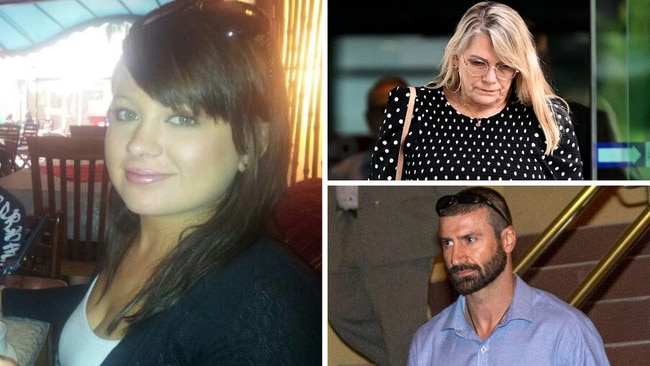
Shandee, who had been walking home from work and cheerfully texting her new boyfriend, was ambushed by an unknown assailant who ran hard and fast across a road to get her. The CCTV of the runner just seconds before the attack is chilling.
Shandee’s blood spilled on to the bitumen and into the gutter. That was where she lay dying as a near neighbour, Ringo, pleaded for ambulance officers to come quickly to tend the fatally wounded woman.
“Oh man, she looks young,” Ringo said in a tone of plaintive resignation. The audio from his recorded emergency call is raw and desperately sad.
Listeners who heard it in the first episode of the podcast Shandee’s Story confess they found it hard to continue.
In the months that followed her murder, Shandee’s former boyfriend John Peros became a major suspect for Mackay police, led by Detective Sergeant Lisa Elkins.
Peros emphatically denied wrongdoing. He was charged over her murder in 2014 and in 2017 his trial ensued in Mackay’s Supreme Court. The verdict was delivered with unusual haste.
“Not guilty,” the jury declared after deliberating for less than two hours.
That’s where this case might have ended if not for the rigour and truth-seeking work of Mackay-based Coroner David O’Connell, who conducted an inquest in 2019 into Shandee’s death.
Unlike the criminal trial, in which skilful lawyers for Peros effectively excluded chunks of evidence against their client while arguing that an Indigenous criminal called William Daniel was the real killer, the 2019 inquest heard much more evidence from more witnesses than the jurors in the murder trial saw or heard.
The coroner delivered a detailed finding in which he concluded that Peros was Shandee’s killer, notwithstanding the jury’s “not guilty” verdict three years earlier.
In my podcast investigation which started in 2021, Shandee’s Story, the tension between the two starkly contrasting outcomes about the same case was unavoidable.
Which finding was right? Had Peros been unfairly targeted by police and the coroner? Had he got away with murder? How did a sophisticated legal system produce such divergent outcomes? Would Shandee and her family ever get justice? These were important questions from the outset.
For the first 13 episodes of the podcast series, listeners heard the evidence of witnesses from the original police investigation and from my subsequent interviews.
We relied on voice actors to reconstruct parts of the legal case and of the murder trial.
A trove of audio and video files from the police investigation as well as other evidence became part of the podcast. And two significant things happened.
First, forensic biologist Kirsty Wright became a heroine by joining the podcast and discovering extraordinary and systemic failure, and scientific corruption, in Queensland’s DNA laboratory, affecting Shandee’s case and thousands of other cases going back years.
Second, Peros and his lawyers alleged that the 13th episode gravely defamed him and caused him “serious harm”.
We prepared for a long and expensive legal battle.
Now, two years after bringing the defamation action against The Australian, Shandee’s sister Shannah Blackburn and me, one of Queensland’s most astute judges has found in our favour.
A costly defamation case has been dismissed because, as judge Peter Applegarth found, Peros had already suffered “serious harm” from the coroner’s damning finding, as well as from the first 12 episodes of the podcast.
Justice Applegarth found: “Those episodes exposed extraordinary shortcomings in the analysis of DNA evidence.
“Listeners to the podcast came to understand, with the benefit of Dr Wright’s analysis and Mr Thomas’s explanations, that the DNA tests were unable to find DNA from the blood samples taken from the crime scene.
“Another theme of the podcast series prior to Episode 13 was that the jury, the judge, the prosecutor, the police, and others were unaware, at the time of the trial, of the deep flaws in the system for DNA testing. These flaws were the subject of many episodes in the podcast series.
“Episodes 1 to 12 left listeners with the strong impression that the prosecution at the trial was outgunned, outmanoeuvred and outplayed by the superior forensic skills of defence counsel and defence solicitors.
“The question of how (Peros) came to be acquitted by the jury but found by the coroner to have killed Ms Blackburn was answered long before Episode 13.
“The answer included different evidence, the different rules that apply to a criminal trial and are tilted in favour of the accused, and the DNA bungle within the state DNA laboratory about which the trial participants were ignorant.”
No part of the judgment of Justice Applegarth, who retires on Friday after an illustrious career, determined who had murdered Shandee Blackburn. That was not his job.
It is as important now, as ever, to stress that notwithstanding the coroner’s finding, Peros has not been convicted of anything relating to Shandee Blackburn.
He has spent a huge amount of money in his failed defamation case as part of his insistence that he did not kill her.
For investigative journalism, Justice Applegarth’s finding is a powerful incentive, and an enormous relief.
Podcasts such as Shandee’s Story are vital for exposing systemic wrongdoing such as we found in the DNA lab, which failed thousands of victims of serious crime.
Nobody in the criminal justice system understood this until Dr Wright started revealing it in the podcast. Her brave work is now ensuring justice for people who would have otherwise been denied it. For these reasons, there has not been a more important story in my 40-year career.
For Shandee’s mother, Vicki Blackburn, who is being separately sued for defamation by John Peros, justice is still an elusive mirage.
The killer of her daughter Shandee, whoever he may be, is still at large. And this is a travesty.




Shortly after midnight in February 2013, Shandee Blackburn was repeatedly stabbed in the face and neck in a frenzied attack near her mother Vicki’s home in Mackay. She was just 23.